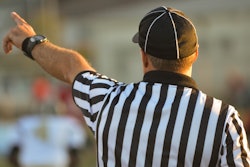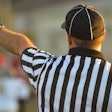The U.S. Food and Drug Administration on Friday authorized the marketing of a device designed to lessen the effects of blows to the head in athletes by helping the brain fit better inside the human skull.
According to a release at fda.gov, the Q-Collar is a C-shaped, non-invasive device that applies compressive force to the neck and increases blood volume to help reduce movement of the brain within the cranial space that may occur during head impacts. The device, which can be worn for up to four hours at a time, may reduce the occurrence of specific changes in the brain that are associated with brain injury.
When worn around the neck during sports activities, the Q-Collar provides compressive force to the internal jugular veins, which in turn increases the blood volume in the skull’s blood vessels, the FDA release states. Typically, when people experience blunt trauma accidents, the brain moves unrestrained in the skull, which is known as a “slosh.” The Q-Collar’s increase in blood volume in those blood vessels creates a tighter fit of the brain inside the skull and reduces the “slosh” movement. By reducing the movement of the brain within the cranial space, the Q-Collar may aid in the protection of the brain from the effects of head impacts.
The FDA further reports that it assessed the safety and effectiveness of the Q-Collar through several studies, including a prospective, longitudinal study in the United States with 284 subjects 13 years or older who were participants on a high school football team. During the sports season, 139 athletes wore the Q-Collar and 145 athletes did not. All participants also wore an accelerometer device that measured every impact to the head sustained during play. Each athlete underwent a magnetic resonance imaging (MRI) scan pre-season and post-season. These MRI scans were used to generate Diffusion Tensor Imaging (a specialized MRI image) of the brain that allowed researchers to compare structural changes in the participants’ brain, after a season of play.
Significant changes were found in deeper tissues of the brain involved in the transmission of electrical nerve signals (white matter regions) in 106 of the 145 (73 percent) participants in the no-Collar group, while no significant changes in these regions were found in 107 of the 139 (77 percent) of the group who wore the Q Collar. These differences appear to indicate protection of the brain associated with device use. No significant adverse events were associated with device use.
The FDA states that the device should be replaced after two years of active use.
“Today’s action provides an additional piece of protective equipment athletes can wear when playing sports to help protect their brains from the effects of repetitive head impacts while still wearing the personal protective equipment associated with the sport,” said Christopher M. Loftus, M.D., acting director of the Office of Neurological and Physical Medicine Devices in the FDA’s Center for Devices and Radiological Health.
The announcement comes with a few caveats.
The Q-Collar does not replace, and should be worn with, other protective sports equipment associated with specific sports activities, such as helmets and shoulder pads. Wearers of the device should not depend on the device to protect them from all harmful effects of head impacts. Users should take steps to avoid direct impact to the head and neck. Data do not demonstrate that the device can prevent concussion or serious head injury. The Q-Collar should not be used if an individual has not been medically cleared to play contact sports.
The Q-Collar has not been tested and should not be used on athletes with certain conditions listed here.





































